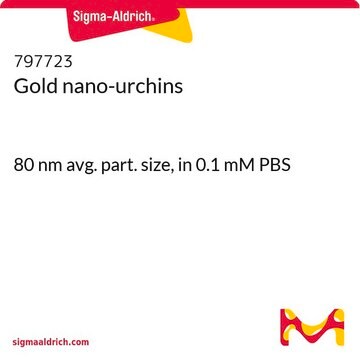Settling of gold nanoparticles on the bottom of the storage flask is completely normal and is especially common for larger sized particles, which settles at greater speed. Settling does not affect the performance of the particles. Prior to use, simply swirl the solution to properly disperse your gold nanoparticles and obtain a homogenous solution.
推薦產品
品質等級
形狀
nanoparticles
suspension
包含
Proprietary Surfactant as stabilizer
濃度
~7.8E+9 particles/mL
外徑
1
直徑
80 nm
λmax
550-557 nm
蛋白質二硫鍵異構酶
<0.2
儲存溫度
2-8°C
SMILES 字串
[Au]
InChI
1S/Au
InChI 密鑰
PCHJSUWPFVWCPO-UHFFFAOYSA-N
尋找類似的產品? 前往 產品比較指南
應用
This material is highly monodisperse (<12% variability in size and shape), and provides significantly improved surface reactivity. Applications include Surface Enhanced Raman Lables, Sensing/Detection, Biological Targeting, Plasmonics and Electronics.
法律資訊
儲存類別代碼
12 - Non Combustible Liquids
水污染物質分類(WGK)
nwg
閃點(°F)
Not applicable
閃點(°C)
Not applicable
客戶也查看了
文章
Steven J. Oldenburg, Ph.D. provides an overview of lateral flow diagnostic assays and discusses the use of ultra-bright reporter particles based on the unique optical properties of gold nanoshells that significantly increase the sensitivity of lateral flow immunoassays.
金 (Au) 奈米微粒具有可調式光學與電子特性,可應用於多種領域,包括光電、感測器、藥物輸送與催化。
Gold (Au) nanoparticles have tunable optical and electronic properties and are used in a number of applications including photovoltaics, sensors, drug delivery & catalysis.
Silver nanomaterials have unique physical, chemical, and optical properties that are currently being leveraged for a wide variety of biological applications.
-
My gold nanoparticles settle out of solution upon storage. Is this normal?
1 answer-
Helpful?
-
-
How do you attach gold nanoparticles to peptides and peptide conjugates?
1 answer-
To view information on how to attach gold nanoparticles to peptides and peptide conjugates, please view the information in the reference - Rosenthal, S. J. and Wright, D. W. (Eds.). (2005), p. 91-92. NanoBiotechnology Protocols. New Jersey. Humana Press.
Helpful?
-
-
What is the Department of Transportation shipping information for this product?
1 answer-
Transportation information can be found in Section 14 of the product's (M)SDS.To access the shipping information for this material, use the link on the product detail page for the product.
Helpful?
-
-
How does the storage temperature relate to shipping conditions?
1 answer-
The storage conditions that a Sigma-Aldrich catalog and label recommend for products are deliberately conservative. For many products, long-term storage at low temperatures will increase the time during which they are expected to remain in specification and therefore are labeled accordingly. Where short-term storage, shipping time frame, or exposure to conditions other than those recommended for long-term storage will not affect product quality, Sigma-Aldrich will ship at ambient temperature. The products sensitive to short-term exposure to conditions other than their recommended long-term storage are shipped on wet or dry ice. Ambient temperature shipping helps to control shipping costs for our customers. At any time, our customers can request wet- or dry-ice shipment, but the special handling is at customer expense if our product history indicates that the product is stable for regular shipment.
Helpful?
-
-
What is the shape of the gold nanoparticles?
1 answer-
The majority (>95%) of the gold nanoparticles are spherical.
Helpful?
-
-
Can the Gold nanoparticles be frozen?
1 answer-
No, the Gold nanoparticles should not be frozen. If frozen, the gold nanoparticles will irreversibly aggregate, turning the solution clear.
Helpful?
-
-
Which gold nanoparticle size should I choose for my application?
1 answer-
The size of gold nanoparticle to use is very depandent upon the intended application. Generally, smaller particles offer better sensitivity in applications such as immunogold labeling due to less steric hindrance and the ability to bind more gold nanoparticles to the desired target. Small gold nanoparticles are less visible than larger particles, however, which must also be taken into account.As an application example, particles with a size between 30-50nm are particularly useful for the development of rapid tests such as lateral flow assays.
Helpful?
-
-
Why does my gold nanoparticle solution turn violet when I add salt containing buffer?
1 answer-
Due to repulsive forces arising from the surface charge of gold nanoparticles, an energy barrier must be overcome for individual particles to interact. When no (or small) amounts of electrolytes such as NaCl is present, this energy barrier is too strong for interaction to occur between particles. However, upon addition of NaCl this energy barrier is reduced allowing the gold nanoparticles to interact and aggregate. This aggregation causes a phenomenon called surface-plasmon coupling which changes the adsorption maximum of light to a higher wavelength resulting in a change in color of the solution.
Helpful?
-
-
How do you attach gold nanoparticles to glass?
1 answer-
To view the procedure on how to attach gold nanoparticles to glass please view information in the reference - Journal of Atomic, Molecular, and Optical PhysicsVolume 2012 (2012). Article ID 683830, 6 pagesdoi:10.1155/2012/683830
Helpful?
-
-
Do I need to wash my gold nanoparticles?
1 answer-
For most applications, our gold nanoparticles can be used without any additional washing steps. If you have a sensitive application that requires additional washing the best way to do so is by either centrifugation or filtration.
Helpful?
-
Active Filters
我們的科學家團隊在所有研究領域都有豐富的經驗,包括生命科學、材料科學、化學合成、色譜、分析等.
聯絡技術服務
